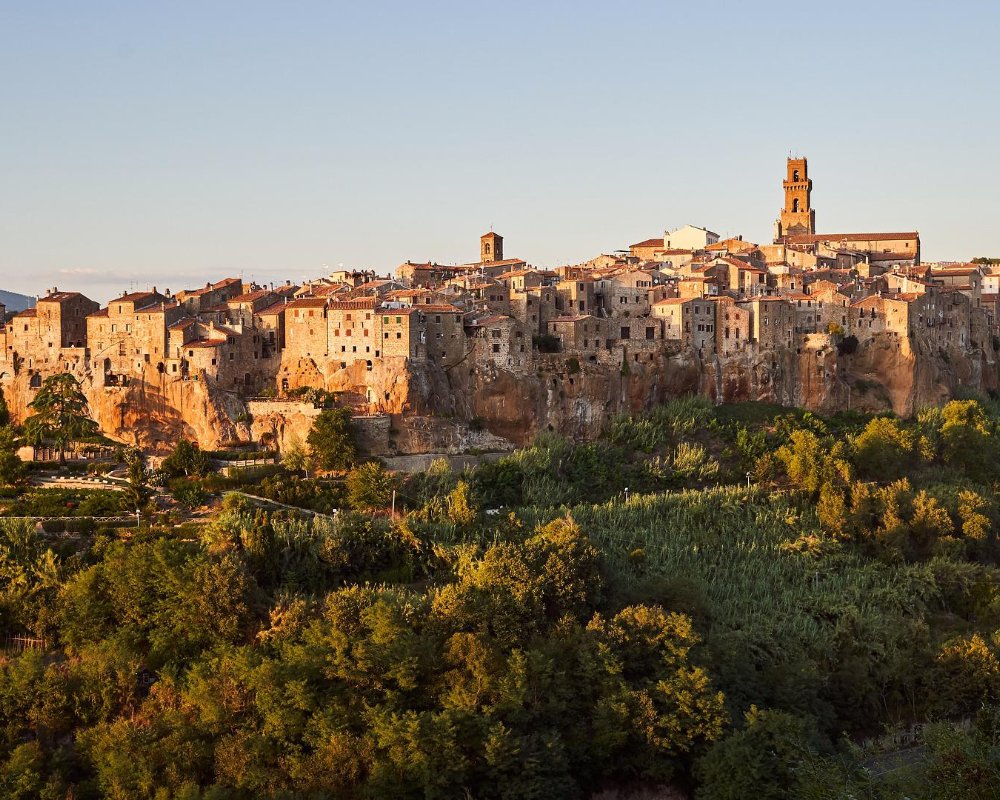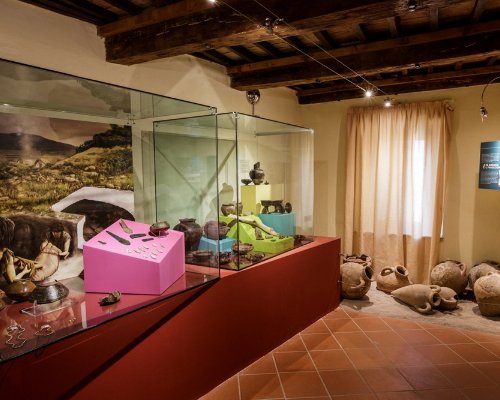An itinerary to discover Scansano, Saturnia, Sovana and Pitigliano
Scansano, Saturnia, Sovana, Pitigliano and more: what do these beautiful and intriguing places in Southern Tuscany have in common? They were the cradle of Etruscan civilisation, the same civilisation that, even today, never fails to astonish travellers.
Villages perched upon the rocks and constructed from tuff stone, mysterious, spiritual streets, traditions and ancient customs: this land radiates history. Those who are curious and fascinated by Etruscan civilisation can follow this itinerary between the hills of Maremma, which leads you through small town centres, vineyards and archaeological sites.
The first stop on the itinerary is Scansano, where the red wine of Morellino di Scansano is produced. It’s no coincidence that you can also find the Wine and Vine Museum here, dedicated to promoting the area’s culture and traditions.
Another unmissable stop is the Archaeological Museum, which documents the history of human settlement in the Valle dell’Albegna with data and materials unearthed during archaeological research carried out over the last thirty years.
Starting from prehistoric times, the journey takes you to some of the region’s most convincing traces of the Etruscan age, like the archaic dwellings and the fortified centre of Ghiaccio Forte, which dates from the Hellenistic age. The tour continues with the Roman Era: you’ll find some reconstructions and images of the villa which stands in the vicinity of Aia Nova, a small farm.
The first stop on the itinerary is Scansano, where the red wine of Morellino di Scansano is produced. It’s no coincidence that you can also find the Wine and Vine Museum here, dedicated to promoting the area’s culture and traditions.
Another unmissable stop is the Archaeological Museum, which documents the history of human settlement in the Valle dell’Albegna with data and materials unearthed during archaeological research carried out over the last thirty years.
Starting from prehistoric times, the journey takes you to some of the region’s most convincing traces of the Etruscan age, like the archaic dwellings and the fortified centre of Ghiaccio Forte, which dates from the Hellenistic age. The tour continues with the Roman Era: you’ll find some reconstructions and images of the villa which stands in the vicinity of Aia Nova, a small farm.
The journey continues onto Saturnia, an area that has brought to light artefacts from the Bronze Age and Etruscan settlements. Of the original city walls, only the southern Porta Romana remains, with its stone cladding and round arch opening, right at the start of the passage to the ancient via Clodia; however, you can still admire what remains from two of the other gates, the Porta Fiorentina and the Porta di Fonte Buia.
The museum, recently rebuilt, houses the archaeological collection of the Ciacci family in the rooms of an unused school complex, vaunting interesting artefacts from the Etruscan era.
Saturnia is also known for its sulphuric water, which flows at a temperature of 37.5° C, making it a prestigious spa town.
The journey continues onto Saturnia, an area that has brought to light artefacts from the Bronze Age and Etruscan settlements. Of the original city walls, only the southern Porta Romana remains, with its stone cladding and round arch opening, right at the start of the passage to the ancient via Clodia; however, you can still admire what remains from two of the other gates, the Porta Fiorentina and the Porta di Fonte Buia.
The museum, recently rebuilt, houses the archaeological collection of the Ciacci family in the rooms of an unused school complex, vaunting interesting artefacts from the Etruscan era.
Saturnia is also known for its sulphuric water, which flows at a temperature of 37.5° C, making it a prestigious spa town.
Let’s move onto Sovana, an intriguing town with an atmosphere frozen in time, a rare jewel of medieval urban planning. It was also a flourishing Etruscan centre. From this period, there is the Etruscan necropolis with its Ildebranda Tomb in the shape of a Greek temple. Following this era, it was an important Roman city, becoming the episcopal centre in the first centuries of Christianity. Necropolises with monumental stone tombs are characteristic of the area, and standing out amongst them, we have the Pola Tomb, the tomb of Tifone, the tomb of Sirena and the tomb of the Winged Demons.
In piazza del Pretorio, the San Mamiliano Museum houses a small vase containing 498 solid gold coins found more than two metres below ground.
Let’s move onto Sovana, an intriguing town with an atmosphere frozen in time, a rare jewel of medieval urban planning. It was also a flourishing Etruscan centre. From this period, there is the Etruscan necropolis with its Ildebranda Tomb in the shape of a Greek temple. Following this era, it was an important Roman city, becoming the episcopal centre in the first centuries of Christianity. Necropolises with monumental stone tombs are characteristic of the area, and standing out amongst them, we have the Pola Tomb, the tomb of Tifone, the tomb of Sirena and the tomb of the Winged Demons.
In piazza del Pretorio, the San Mamiliano Museum houses a small vase containing 498 solid gold coins found more than two metres below ground.
The fourth stop on the journey is Sorano, where you’ll find the “Città del Tufo” Archaeological Park, whose landscape has remained practically untouched and is characterised by picturesque shapes of tuff reliefs criss-crossed by deep valleys of vegetation. The park includes the Etruscan necropolis of Sovana and the stone settlements of San Rocco and Vitozza.
The fourth stop on the journey is Sorano, where you’ll find the “Città del Tufo” Archaeological Park, whose landscape has remained practically untouched and is characterised by picturesque shapes of tuff reliefs criss-crossed by deep valleys of vegetation. The park includes the Etruscan necropolis of Sovana and the stone settlements of San Rocco and Vitozza.
Pitigliano is situated on a beautiful tuff promontory, bordered by lush green valleys and traversed by the Lente and Meleta rivers.
Its main characteristic is the contrast between its Etruscan-Roman layout and the general medieval urban appearance, in which monuments from the Renaissance and the late Renaissance stand side by side. The Medici aqueduct dominates the town, while of particular note amongst the beautiful buildings is Palazzo Orsini, which dates to the 14th century but has been renovated many times. Today it houses the Diocesan Museum and the Civic Archaeology Museum. A walk through the streets of the historical centre inevitably leads to the cathedral, with its beautiful Baroque façade and mighty bell tower. In the area where the ghetto used to be, you can visit the ruins of the synagogue and the Jewish museum.
The Vie Cave, in the area surrounding Pitigliano, are pathways excavated into the tuff, with walls often as high as 20 metres, some around a kilometre long, and about two or three metres wide; in a few places, these pathways are closed at the top by tree branches, forming a green and shady gallery. At the bottom, there is evidence of the hoof tracks of donkeys that have passed through here for centuries, used as a means of transport that once accompanied men to work in the countryside.
Pitigliano is situated on a beautiful tuff promontory, bordered by lush green valleys and traversed by the Lente and Meleta rivers.
Its main characteristic is the contrast between its Etruscan-Roman layout and the general medieval urban appearance, in which monuments from the Renaissance and the late Renaissance stand side by side. The Medici aqueduct dominates the town, while of particular note amongst the beautiful buildings is Palazzo Orsini, which dates to the 14th century but has been renovated many times. Today it houses the Diocesan Museum and the Civic Archaeology Museum. A walk through the streets of the historical centre inevitably leads to the cathedral, with its beautiful Baroque façade and mighty bell tower. In the area where the ghetto used to be, you can visit the ruins of the synagogue and the Jewish museum.
The Vie Cave, in the area surrounding Pitigliano, are pathways excavated into the tuff, with walls often as high as 20 metres, some around a kilometre long, and about two or three metres wide; in a few places, these pathways are closed at the top by tree branches, forming a green and shady gallery. At the bottom, there is evidence of the hoof tracks of donkeys that have passed through here for centuries, used as a means of transport that once accompanied men to work in the countryside.
If you’re not tired yet, you can treat yourself to one more stop: Manciano, a town nestled atop a hill and defended by a robust wall. It’s an excellent position for sightings, revealing the high strategic importance that the city had as an observatory and lookout spot. The numerous small villages in this area are home to necropolises like Marsiliana and Pian di Palma. Once upon a time, the city was highly developed and formed close relations with other Etruscan cities (Vulci, Roselle, Vetulonia).
A sight worth seeing there is the Museum of Prehistory and Protohistory, with its Neolithic artefacts ranging from the Copper Age to the Bronze Age.


